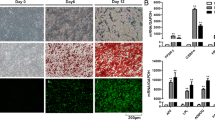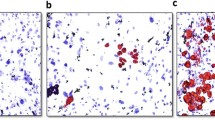Abstract
Breast cancer progression and metastasis are associated with stromal cells in the tumor microenvironment. Adipocytes are the most abundant cells surrounding breast stromal tissue, promote tumor progression through the induction of Epithelial-to-Mesenchymal Transition (EMT) which is negatively regulated by tumor suppressor protein p53. In this study aimed to investigate the role of p53 in the progression of breast cancer after mature adipocyte-conditioned medium (CM) application. The proliferative effect of CM obtained from differentiated pre-adipocytes were assessed by MTS assay. 20% CM increased cell proliferation in breast cancer cells, T-47D (mutant p53) and MCF-7 (wild-type p53). The migration and invasion capacity were evaluated by scratch and transwell assays, respectively. CM significantly enhanced migration and invasion capacity in T-47D compared to MCF-7. Gene and protein expressions were detected by qRT-PCR and Western Blot analysis, respectively. CM markedly increased expression levels of Cyclin D1, PI3K, MMP9, Snail and Twist in T-47D compared to MCF-7. However, CM did not change E-Cadherin level in T-47D while downregulated in MCF-7 cells. Also, the protein levels of NFκB p65, p-Akt, Snail, and Vimentin were upregulated in both cells. Overall, the findings highlight how the p53 status affects mature adipocyte-mediated proliferation, migration, and aggressive behavior of breast cancer cell lines. Targeting the tumor microenvironment may represent a promising approach for preventing breast cancer progression and metastasis.




Similar content being viewed by others
References
Torre LA, Bray F, Siegel RL et al (2015) Global cancer statistics. CA Cancer J Clin 65:87–108. https://doi.org/10.3322/caac.21262
Xu H, Li W, Luo S et al (2019) Adipose derived stem cells promote tumor metastasis in breast Cancer cells by stem cell factor inhibition of miR20b. Cell Signal 62:109350. https://doi.org/10.1016/j.cellsig.2019.109350
Huang C-K, Chang P-H, Kuo W-H et al (2017) Adipocytes promote malignant growth of breast tumours with monocarboxylate transporter 2 expression via $β$-hydroxybutyrate. Nat Commun 8:1–13. https://doi.org/10.1038/ncomms14706
Orimo A, Gupta PB, Sgroi DC et al (2005) Stromal fibroblasts present in invasive human breast carcinomas promote tumor growth and angiogenesis through elevated SDF-1/CXCL12 secretion. Cell 121:335–348. https://doi.org/10.1016/j.cell.2005.02.034
Tyan S-W, Kuo W-H, Huang C-K et al (2011) Breast cancer cells induce cancer-associated fibroblasts to secrete hepatocyte growth factor to enhance breast tumorigenesis. PLoS ONE 6:e15313. https://doi.org/10.1371/journal.pone.0015313
Wang Y-Y, Lehuédé C, Laurent V et al (2012) Adipose tissue and breast epithelial cells: a dangerous dynamic duo in breast cancer. Cancer Lett 324:142–151. https://doi.org/10.1016/j.canlet.2012.05.019
Gyamfi J, Lee Y-H, Eom M, Choi J (2018) Interleukin-6/STAT3 signalling regulates adipocyte induced epithelial-mesenchymal transition in breast cancer cells. Sci Rep 8:1–13. https://doi.org/10.1038/s41598-018-27184-9
Lin C-Y, Tsai P-H, Kandaswami CC et al (2011) Matrix metalloproteinase-9 cooperates with transcription factor Snail to induce epithelial–mesenchymal transition. Cancer Sci 102:815–827. https://doi.org/10.1111/j.1349-7006.2011.01861.x
Hu J, Liu Z, Wang X (2013) Does TP53 mutation promote ovarian cancer metastasis to omentum by regulating lipid metabolism? Med Hypotheses 81:515–520
Powell E, Piwnica-Worms D, Piwnica-Worms H (2014) Contribution of p53 to metastasis. Cancer Discov 4:405–414
Brosh R, Rotter V (2009) When mutants gain new powers: news from the mutant p53 field. Nat Rev Cancer 9:701–713
Dirat B, Bochet L, Dabek M et al (2011) Cancer-associated adipocytes exhibit an activated phenotype and contribute to breast cancer invasion. Can Res 71:2455–2465
Balaban S, Shearer RF, Lee LS et al (2017) Adipocyte lipolysis links obesity to breast cancer growth: adipocyte-derived fatty acids drive breast cancer cell proliferation and migration. Cancer Metab 5:1–14. https://doi.org/10.1186/s40170-016-0163-7
Manabe Y, Toda S, Miyazaki K, Sugihara H (2003) Mature adipocytes, but not preadipocytes, promote the growth of breast carcinoma cells in collagen gel matrix culture through cancer–stromal cell interactions. J Pathol 201:221–228
Osman MA, Hennessy BT (2015) Obesity correlation with metastases development and response to first-line metastatic chemotherapy in breast cancer. Clin Med Insights Oncol. https://doi.org/10.4137/CMO.S32812
Turan D, Abdik H, Sahin F, Abdik EA (2020) Evaluation of the neuroprotective potential of caffeic acid phenethyl ester in a cellular model of Parkinson’s disease. Eur J Pharmacol 883:173342. https://doi.org/10.1016/j.ejphar.2020.173342
Shiozawa Y, Eber MR, Berry JE, Taichman RS (2015) Bone marrow as a metastatic niche for disseminated tumor cells from solid tumors. Bonekey Rep. https://doi.org/10.1038/bonekey.2015.57
Park CG, Hartl CA, Schmid D et al (2018) Extended release of perioperative immunotherapy prevents tumor recurrence and eliminates metastases. Sci Transl Med 10:eaar1916. https://doi.org/10.1126/scitranslmed.aar1916
Kushiro K, Chu RA, Verma A, Núñez NP (2012) Adipocytes promote B16BL6 melanoma cell invasion and the epithelial-to-mesenchymal transition. Cancer Microenviron 5:73–82. https://doi.org/10.1007/s12307-011-0087-2
Wang C, Gao C, Meng K et al (2015) Human adipocytes stimulate invasion of breast cancer MCF-7 cells by secreting IGFBP-2. PLoS ONE 10:e0119348. https://doi.org/10.1371/journal.pone.0119348
Iyengar NM, Gucalp A, Dannenberg AJ, Hudis CA (2016) Obesity and cancer mechanisms: tumor microenvironment and inflammation. J Clin Oncol 34:4270. https://doi.org/10.1200/JCO.2016.67.4283
Zhang Y, Daquinag AC, Amaya-Manzanares F et al (2012) Stromal progenitor cells from endogenous adipose tissue contribute to pericytes and adipocytes that populate the tumor microenvironment. Cancer Res 72:5198–5208. https://doi.org/10.1158/0008-5472
Hoy AJ, Balaban S, Saunders DN (2017) Adipocyte–tumor cell metabolic crosstalk in breast cancer. Trends Mol Med 23:381–392
Kim HO, Choi S-M, Kim H-S (2013) Mesenchymal stem cell-derived secretome and microvesicles as a cell-free therapeutics for neurodegenerative disorders. Tissue Eng Regen Med 10:93–101. https://doi.org/10.1007/s13770-013-0010-7
Park B-S, Kim W-S, Choi J-S et al (2010) Hair growth stimulated by conditioned medium of adipose-derived stem cells is enhanced by hypoxia: evidence of increased growth factor secretion. Biomed Res 31:27–34
Song R, Tian K, Wang W, Wang L (2015) P53 suppresses cell proliferation, metastasis, and angiogenesis of osteosarcoma through inhibition of the PI3K/AKT/mTOR pathway. Int J Surg 20:80–87
Zhang X, Cheng Q, Yin H, Yang G (2017) Regulation of autophagy and EMT by the interplay between p53 and RAS during cancer progression. Int J Oncol 51:18–24
Muller PAJ, Vousden KH, Norman JC (2011) p53 and its mutants in tumor cell migration and invasion. J Cell Biol 192:209–218
Carter JC, Church FC (2012) Mature breast adipocytes promote breast cancer cell motility. Exp Mol Pathol 92:312–317. https://doi.org/10.1016/j.yexmp.2012.03.005
Lee Y, Jung WH, Koo JS (2015) Adipocytes can induce epithelial-mesenchymal transition in breast cancer cells. Breast Cancer Res Treat 153:323–335. https://doi.org/10.1007/s10549-015-3550-9
D’Esposito V, Liguoro D, Ambrosio MR et al (2016) Adipose microenvironment promotes triple negative breast cancer cell invasiveness and dissemination by producing CCL5. Oncotarget 7:24495. https://doi.org/10.18632/oncotarget.8336
Zuo J-H, Zhu W, Li M-Y et al (2011) Activation of EGFR promotes squamous carcinoma SCC10A cell migration and invasion via inducing EMT-like phenotype change and MMP-9-mediated degradation of E-cadherin. J Cell Biochem 112:2508–2517. https://doi.org/10.1002/jcb.23175
Chaffer CL, Weinberg RA (2011) A perspective on cancer cell metastasis. Science 331:1559–1564. https://doi.org/10.1126/science.1203543
Bonnomet A, Brysse A, Tachsidis A et al (2010) Epithelial-to-mesenchymal transitions and circulating tumor cells. J Mammary Gland Biol Neoplasia 15:261–273. https://doi.org/10.1007/s10911-010-9174-0
Barrallo-Gimeno A, Nieto MA (2005) The Snail genes as inducers of cell movement and survival: implications in development and cancer. Development 132:3151–3161. https://doi.org/10.1242/dev.01907
Guarino M (2007) Epithelial–mesenchymal transition and tumour invasion. Int J Biochem Cell Biol 39:2153–2160. https://doi.org/10.1016/j.biocel.2007.07.011
Thomas PA, Kirschmann DA, Cerhan JR et al (1999) Association between keratin and vimentin expression, malignant phenotype, and survival in postmenopausal breast cancer patients. Clin Cancer Res 5:2698–2703
Roger L, Jullien L, Gire V, Roux P (2010) Gain of oncogenic function of p53 mutants regulates E-cadherin expression uncoupled from cell invasion in colon cancer cells. J Cell Sci 123:1295–1305
Yu Y, Xiao CH, Tan L et al (2014) Cancer-associated fibroblasts induce epithelial–mesenchymal transition of breast cancer cells through paracrine TGF-β signalling. Br J Cancer 110:724–732. https://doi.org/10.1038/bjc.2013.768
Acknowledgements
The study was supported by Yeditepe University.
Author information
Authors and Affiliations
Contributions
Conceptualization; Methodology; Formal analysis and investigation; Writing— original draft; Writing—review and editing: EAA.
Corresponding author
Ethics declarations
Conflict of interest
The author declare no conflicts of interest.
Ethical approval
This study does not require ethical statement.
Additional information
Publisher's Note
Springer Nature remains neutral with regard to jurisdictional claims in published maps and institutional affiliations.
Rights and permissions
About this article
Cite this article
Avşar Abdik, E. Differentiated pre-adipocytes promote proliferation, migration and epithelial-mesenchymal transition in breast cancer cells of different p53 status. Mol Biol Rep 48, 5187–5198 (2021). https://doi.org/10.1007/s11033-021-06521-8
Received:
Accepted:
Published:
Issue Date:
DOI: https://doi.org/10.1007/s11033-021-06521-8




